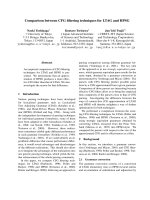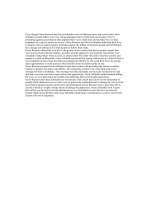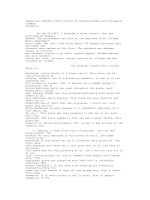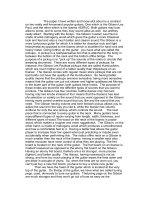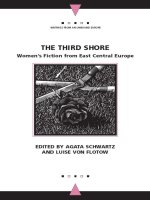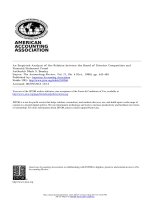comparison between piano concert by barbara wieman and sacramento chamber
Bạn đang xem bản rút gọn của tài liệu. Xem và tải ngay bản đầy đủ của tài liệu tại đây (30.31 KB, 3 trang )
Comparison Between Piano Concert by Barbara Wieman and Sacramento
Chamber
Orchestra
On Feb 20,1997, I attended a piano concert that was
performed by Barbara
Wieman. The performance was held at the American River College
Music Department
choir room. The choir room holds about 100 people and every seat
was taken and
students were seated on the floor. The audience was dressed
casual as everyone
was students trying to do their concert papers. Barbara Weiman
was also dressed
casual but nice. The piano concert started at 12:20pm and was
finished at 1:05pm.
The program started with a piece
from L.V.
Beethoven called Sonata in F minor, Op.57. This piece can be
characterized by an
intense, dramatic use of fluctuating dynamics. It was as if the
crescendo was
not allowed to climax, then is aborted by a sudden change to
pianissimo. The so
called Beethoven motif was used throughout the piece, very
effectively I might
add. Barbara Wieman was very animated performing this piece and
seemed to be
very emotional while playing. This piece was very distinct and
there was an
effective use of rests that was displayed. I would call this
piece very serious.
After Beethoven we were treated to F. Schuberts Impromptu in G
flat Major, Op.
90, No.3. This piece was very pleasing to the ear so we could
call this
consonant. The music seemed to flow and had a great rhythm. This
piece was
romantic in nature and probably that is why it was written in the
romantic era.
C. Debussy ‘s Feux d'artifice (fireworks) was the next
piece played. The
harmony was very obscured in this piece of music. The theme
trying to be
presented in this piece was as if fireworks were going off. The
notes were
ever changing and there was a very good uses of all the keys of
the piano.
This piece was not very pleasing at all and I did not care for it
at all.
From looking around the room it seemed other people would agree.
After that
unpleasant piece was played we were lead into La Cathedrale
engloutie (The
Sunken Cathedral). It was very slow starting but eventually
started building the
tempo and then seemed to drop off and become very slow in tempo.
This piece
seemed as if it were trying to tell a story. Alot of people
seemed as if the
were going to sleep.
The last piece was changed from S. Prokofieff to Chopin's
Ocean Atrium piece.
This piece had rhapsodic melodies giving the illusion that the
piece might
have been improvised. It was very moving and flowing using melody
and harmony.
Very pleasing and also from the romantic era. What a great way to
end the
piano concert. Everyone enjoyed the music so much that she
provided us with an
encore. She played another piece by Chopin. I would definitely
recommend to
anyone wanting to learn more about music to take your class. This
has been a
great experience for me.
On Feb 15,1997, I attended a concert put on by the
Sacramento Chamber
Orchestra. The performance was held at the Dietrich Threatre,
Sierra College in
Rocklin. Dietrich Threatre seats about 500 people, and on that
evening there was
about 300 people present. The concert dress was casual for the
audience but the
Sacramento Chamber Orchestra performers were dressed in tuxedo's
for the men and
black outfits for the women. The performers consisted of 8 women
and 10 men. The
orchestra was conducted by Zvonimir Hacko. Programs were provided
and the
concert followed the printed program very well. The starting time
was 8:00pm and
finished at 10:00pm.
The style of music played varied because of all the
different musical
era's represented. Mozart from the classical era, Dvorak from the
romantic era,
Bartok from the early 20th century, and Copland from our present.
The Sacramento
Chamber Orchestra consisted of Violin 1, Violin 2, Viola,
Violoncello, Double
Bass, Piano, and Harp. When combined, the performance was
outstanding and
uplifting.
The concert opened with Mozart's marvelous miniature,
“Eine Kleine
Nachtmusik” which stands for (“A Little Serenade”). Mozart's
Serenade, which is
like a tiny symphony, was conducted and played with exemplary
care. The tempo of
the music was upbeat, it's dynamics were managed thoughtfully,
and the musical
form presented consisted of alterations that were superb. The
“romance” of the
second movement was hushed and tender, the finale was as light as
air.
After the finale of Mozart's we were treated to the
Dvorak Serenade in E
opus 22. The Dvorak was in five movements lasting a little over
half an hour.
The waltzes of the second were a bit of folk flavor, and were
quite beautiful.
The third movement, Scherzo, was dance like and soulfully
romantic. The fourth
movement,Larghetto, was even more soulful in mood, which deepened
as its melody
passed from the violas to the cellos. The finale brought us back
with a touching
recollection of the very beginning of the work.
The Bartok Divertimento was in three movements. It can be
best described as
continuous, fascinating, exciting and full of action. The
melodies were strong,
as were the rhythmic pulses and dissonance's. So much was
happening that all you
could do was go for the ride and enjoy it. The last major piece
was by Copland,
called Concerto for Clarinet and String Orchestra with Harp and
Piano.
The Copland piece was in two movements bridged by an
unusually long cadenza
(Soloist), that lasted over three minutes. The soloist seemed to
dwell on
the lyric sweetness of the first movement and then signaled the
merriment of
the second movement. The first part struck me as very slow but
the second part
was very rhythmic,very perky, and was passed around
appreciatively by all,
while the piano and clarinet were trading ideas with each other.
All in all,
this piece signaled excitement and was made very enjoyable with
the clarinet
and piano. As this was my first Chamber Concert I was not sure
what to expect.
I thoroughly enjoyed myself and I'm looking forward to my next
concert.
